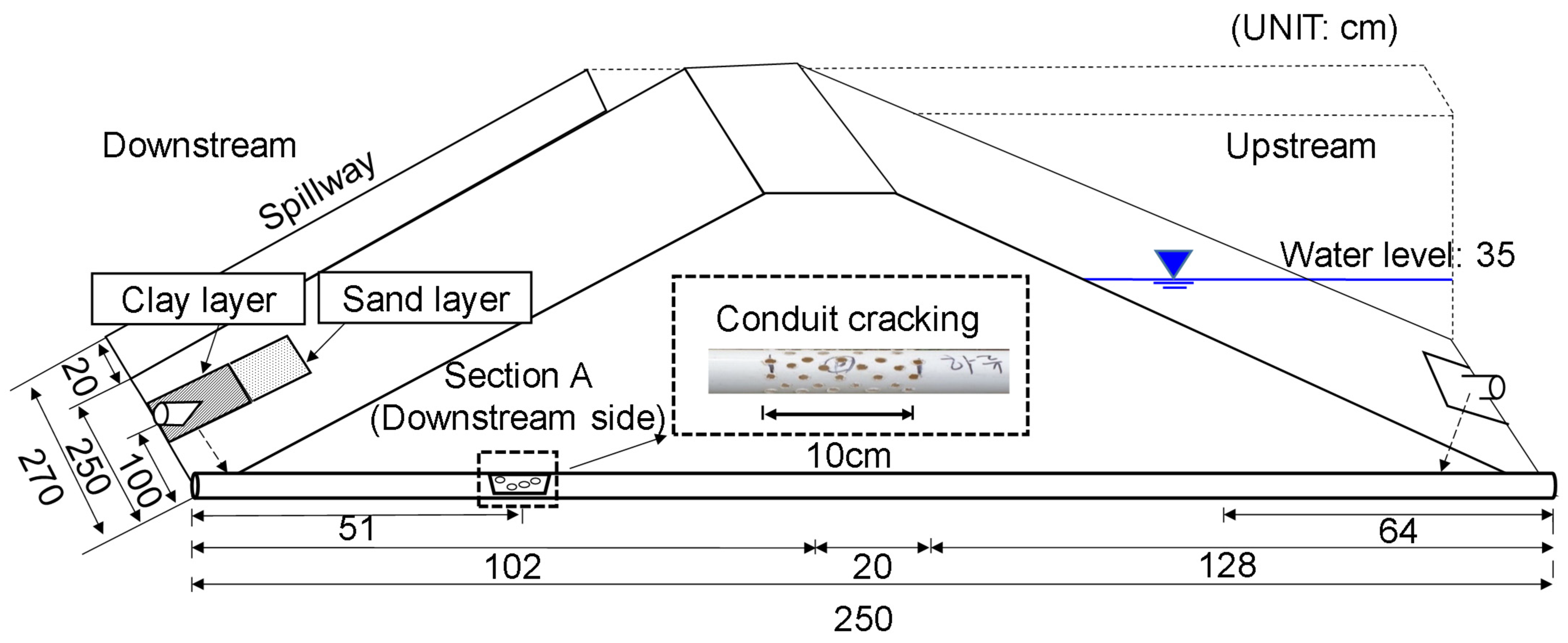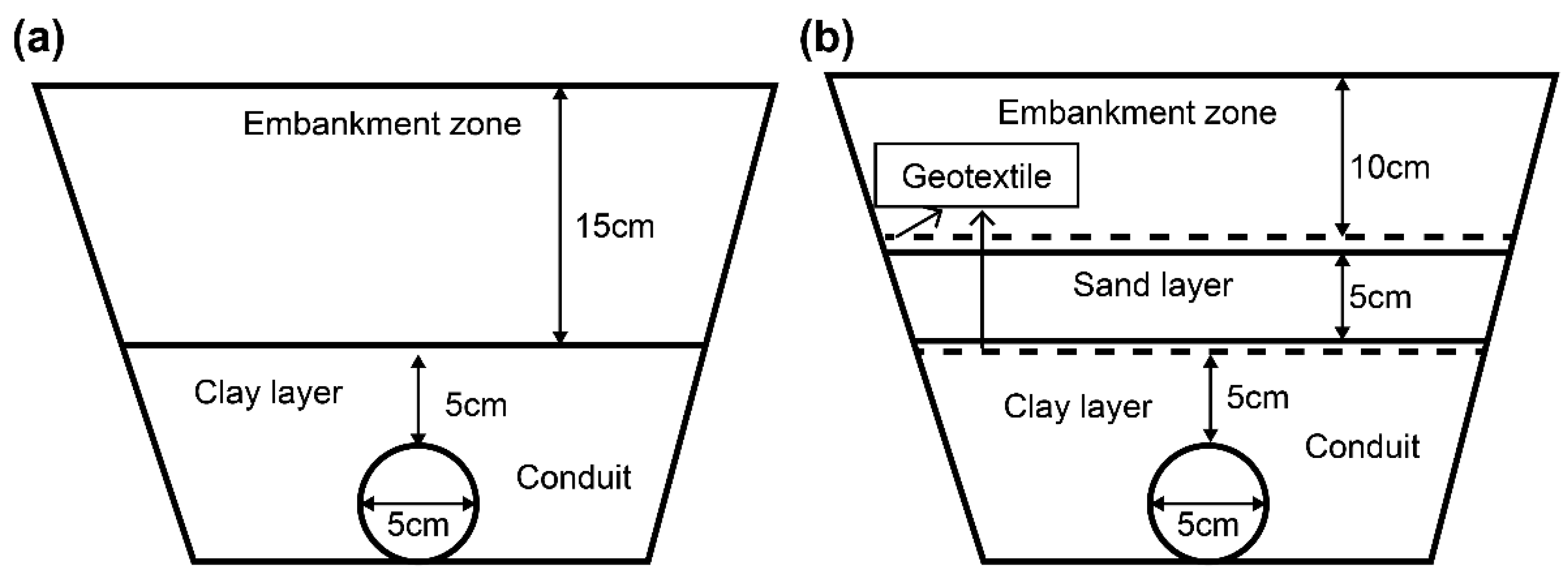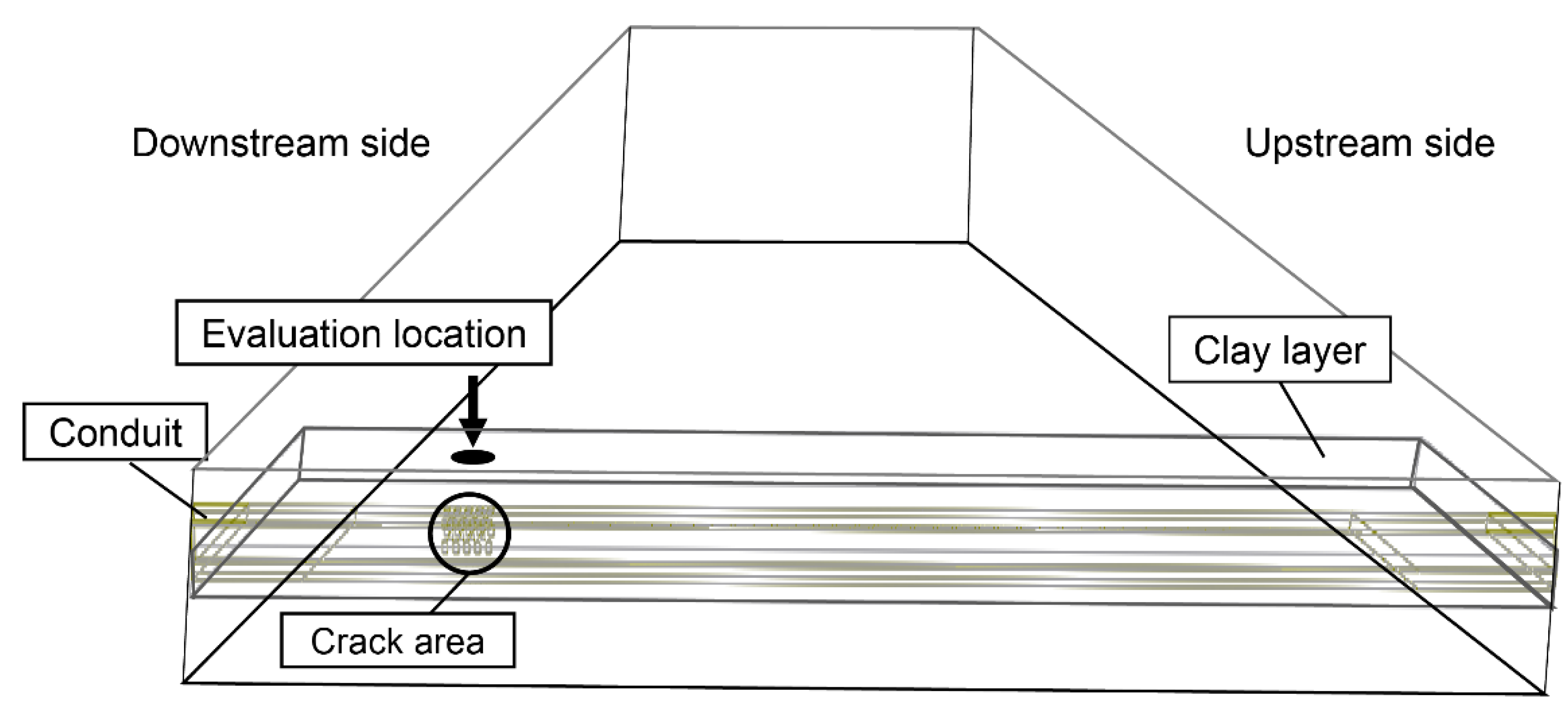Stability Improvement Method for Embankment Dam with Respect to Conduit Cracks
Abstract
:Featured Application
Abstract
1. Introduction
2. Materials and Methods
2.1. Target Reservoirs and Samples
2.2. Measurement Location and Experimental Conditions
2.3. Experimental Models
3. Results and Discussion
3.1. Investigation of Erosion of Current and Improvement Models
3.2. Pore Water Pressure Distribution: Model Experiment
3.3. Seepage Line and Hydraulic Gradient: Numerical Analysis
3.3.1. Analysis Conditions
3.3.2. Change in Seepage Line
3.3.3. Change in Hydraulic Gradient
4. Conclusions
Author Contributions
Funding
Institutional Review Board Statement
Informed Consent Statement
Data Availability Statement
Acknowledgments
Conflicts of Interest
References
- Skempton, A.W. Embankments and cuttings on the early railways. Constr. Hist. 1996, 11, 33–49. [Google Scholar]
- Coleman, S.E.; Andrews, D.P.; Grant Webby, M.G. Overtopping breaching of noncohesive homogeneous embankments. J. Hydraul. Eng. 2002, 128, 829–838. [Google Scholar] [CrossRef]
- Fell, R.; Wan, C.F.; Cyganiewiewicz, J.; Foster, M. Time for development of erosion and piping in embankment dams. J. Geotech. Geoenviron. Eng. 2003, 129, 307–314. [Google Scholar] [CrossRef]
- Flores-Berrones, R.; Ramírez-Reynaga, M.; Jose Macari, E. Internal erosion and rehabilitation of an earth-rock dam. J. Geotech. Geoenviron. Eng. 2011, 137, 151–160. [Google Scholar] [CrossRef]
- Fox, G.A.; Felice, R.G.; Midgley, T.L.; Wilson, G.V.; Al-Madhhachi, A.T. Laboratory soil piping and internal erosion experiment: Evaluation of a soil piping model for low-compacted soils. Earth Surf. Process. Landf. 2014, 39, 1137–1145. [Google Scholar] [CrossRef]
- Lee, D.W.; Noh, J.J. Behavior of failure on agricultural reservoirs embankment by riprap reinforcement method. J. Korean Soc. Agric. Eng. 2014, 56, 63–73. (In Korean) [Google Scholar]
- Lee, Y.H.; Lee, T.H.; Lee, D.W. Overtopping model experiments and 3-D seepage characteristics of the embankment of deteriorated homogeneous reservoirs. J. Korean Soc. Agric. Eng. 2019, 61, 13–23. (In Korean) [Google Scholar]
- Ngambi, S.; Nakano, R.; Shimizu, H.; Nishimura, S. Cause of leakage along the outlet conduit underneath a low fill dam with special reference to hydraulic fracturing. Trans. Jpn. Soc. Irrigation Drain. Reclam. Eng. 1997, 188, 263–272. [Google Scholar]
- Tran, D.Q.; Nishimura, S.; Senge, M.; Nishiyama, T. Research on cause of dam failure from viewpoint of hydraulic fracturing—Case study of a dam failure in Vietnam. Int. J. GEOMATE 2018, 14, 86–94. [Google Scholar] [CrossRef]
- Tran, D.Q.; Nishimura, S.; Senge, M.; Nishiyama, T. Effects of culvert shapes on potential risk of hydraulic fracturing adjacent to culverts in embankment dams. Int. J. GEOMATE 2018, 15, 38–44. [Google Scholar] [CrossRef]
- Wan, C.F.; Fell, R. Investigation of rate of erosion of soils in embankment dams. J. Geotech. Geoenviron. Eng. 2004, 130, 373–380. [Google Scholar] [CrossRef]
- Korea Rural Community Corporation (KRC). Report on the Failure of the Embankment of the Angang Sandae Reservoir; Report of Korea Rural Community Corporation; KRC: Naju-si, Korea, 2013. (In Korean) [Google Scholar]
- Ministry of Agriculture, Food and Rural Affairs (MAFRA). Agricultural Infrastructure Design Standards; MAFRA: Sejong, Korea, 2002. (In Korean) [Google Scholar]
- Cesare, J.A.; Brauer, D.J. Pinery Dam Outlet Conduit Repair, Biennial Geotechnical Symposium 2004. 26 April 2012. Available online: https://doi.org/10.1061/40758(151)13 (accessed on 6 December 2021).
- Federal Energy Regulatory Commission (FERC). Guidelines for Drilling in and near Embankment Dams and Their Foundations, Version 3.1; Division of Dam Safety and Inspections; FERC: Washington, DC, USA, 2016. [Google Scholar]
- US Army Corps of Engineers (USACE). Engineering and Design—Drilling in Earth Embankment Dams and Levees; ER 1110-1-1807; USACE: Washington, DC, USA, 2014. [Google Scholar]
- Lee, Y.H.; Park, S.Y.; Tokida, K.I.; Lee, D.W. Three-dimensional seepage characteristics of reservoir embankment considering interval of horizontal filter. Int. J. Offshore Polar Eng. 2018, 28, 80–86. [Google Scholar] [CrossRef]
- Foster, M.A.; Fell, R.; Spannagle, M. The statistics of embankment dam failures and accidents. Can. Geotech. J. 2000, 37, 1000–1024. [Google Scholar] [CrossRef]
- Federal Emergency Management Agency (FEMA). Technical Manual: Conduits through Embankment Dams: Best Practices for Design, Construction, Problem Identification and Evaluation, Inspection, Maintenance, Renovation, and Repair; FEMA: Washington, DC, USA, 2005. [Google Scholar]
- MIDAS IT. Midas Geotechnical and Tunnel Analysis System (Midas GTS). 2020. Available online: https://www.midasgeotech.com/blog/tag/geotechnical-engineering (accessed on 20 October 2020).
- Carsel, R.F.; Parrish, R.S. Developing joint probability distributions of soil water retention characteristics. Water Resour. Res. 1988, 24, 755–769. [Google Scholar] [CrossRef] [Green Version]
- Ojha, C.S.P.; Singh, V.P.; Adrian, D.D. Influence of porosity on piping models of levee failure. J. Geotech. Geoenviron. Eng. 2001, 127, 1071–1074. [Google Scholar] [CrossRef]
- Ojha, C.S.P.; Singh, V.P.; Adrian, D.D. Determination of critical head in soil piping. J. Geotech. Geoenviron. Eng. 2003, 129, 511–518. [Google Scholar] [CrossRef]
- United States Society on Dams (USSD). The Aging of Embankment Dams. 2010. Available online: https://www.ussdams.org/wp-content/uploads/2016/05/aging.pdf (accessed on 20 October 2020).
- Ke, L.; Takahashi, A. Strength reduction of cohesionless soil due to internal erosion induced by one-dimensional upward seepage flow. Soils Found. 2012, 52, 698–711. [Google Scholar] [CrossRef] [Green Version]
- Terzaghi, K.; Peck, R.B. Soil Mechanics in Engineering Practice, 2nd ed.; John Wiley and Sons, Inc.: New York, NY, USA, 1967; p. 729. [Google Scholar]










| Sample | (%) | (%) | (kN/m3) | (kPa) | (m/s) | USCS | ||
|---|---|---|---|---|---|---|---|---|
| Clay layer | 2.76 | 8.6 | - | 13.66 | 29.43 | 0 | 3.70 × 10−9 | CL |
| Embankment | 2.65 | 9.2 | 8.6 | 17.75 | 16.70 | 24 | 2.37 × 10−7 | SC |
| Sand layer | 2.65 | NP | 12.7 | 17.00 | 0 | 33 | 7.82 × 10−4 | SP |
| Geotextile | - | - | - | - | - | - | 1.00 × 10−3 | - |
| Model | Case Number | Crack Location of Conduit | Section Location |
|---|---|---|---|
| Current model | Case 1—Crack | Downstream side | Section A |
| Case 1—Reinforcement | - | - | |
| Improvement model | Case 2—Crack | Downstream side | Section A |
| Case 2—Reinforcement | - | - |
| Sample | ν | (kPa) | (m/s) | ||
|---|---|---|---|---|---|
| Clay layer | 0.40 | 0.98 | 29.43 | 0 | 3.70 × 10−9 |
| Embankment | 0.35 | 0.48 | 16.70 | 24 | 2.37 × 10−7 |
| Sand layer | 0.33 | 0.50 | 0 | 33 | 7.82 × 10−4 |
| Geotextile | 0.30 | - | - | - | 1.00 × 10−3 |
| Sample | |||||
|---|---|---|---|---|---|
| Clay layer | 0.38 | 0.007 | 0.8 | 1.09 | 0.083 |
| Embankment | 0.46 | 0.034 | 1.6 | 1.37 | 0.270 |
| Sand layer | 0.43 | 0.045 | 14.5 | 2.68 | 0.627 |
Publisher’s Note: MDPI stays neutral with regard to jurisdictional claims in published maps and institutional affiliations. |
© 2022 by the authors. Licensee MDPI, Basel, Switzerland. This article is an open access article distributed under the terms and conditions of the Creative Commons Attribution (CC BY) license (https://creativecommons.org/licenses/by/4.0/).
Share and Cite
Lee, Y.-H.; Ryu, J.-H.; Heo, J.; Shim, J.-W.; Lee, D.-W. Stability Improvement Method for Embankment Dam with Respect to Conduit Cracks. Appl. Sci. 2022, 12, 567. https://doi.org/10.3390/app12020567
Lee Y-H, Ryu J-H, Heo J, Shim J-W, Lee D-W. Stability Improvement Method for Embankment Dam with Respect to Conduit Cracks. Applied Sciences. 2022; 12(2):567. https://doi.org/10.3390/app12020567
Chicago/Turabian StyleLee, Young-Hak, Jung-Hyun Ryu, Joon Heo, Jae-Woong Shim, and Dal-Won Lee. 2022. "Stability Improvement Method for Embankment Dam with Respect to Conduit Cracks" Applied Sciences 12, no. 2: 567. https://doi.org/10.3390/app12020567
APA StyleLee, Y.-H., Ryu, J.-H., Heo, J., Shim, J.-W., & Lee, D.-W. (2022). Stability Improvement Method for Embankment Dam with Respect to Conduit Cracks. Applied Sciences, 12(2), 567. https://doi.org/10.3390/app12020567






